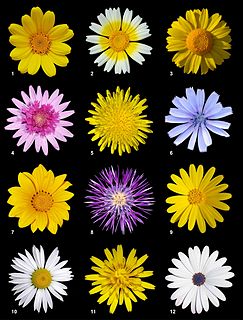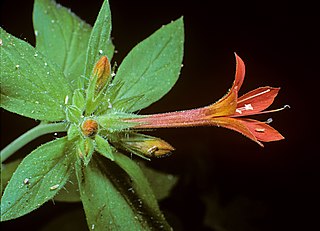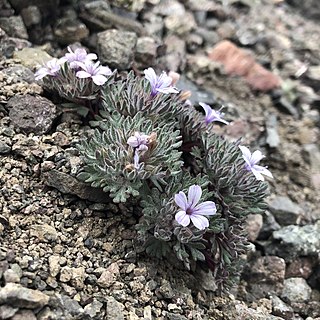
The family Asteraceae, alternatively Compositae, consists of over 32,000 known species of flowering plants in over 1,900 genera within the order Asterales. Commonly referred to as the aster, daisy, composite, or sunflower family, Compositae were first described in the year 1740. The number of species in Asteraceae is rivaled only by the Orchidaceae, and which is the larger family is unclear as the quantity of extant species in each family is unknown.

Apiaceae or Umbelliferae is a family of mostly aromatic flowering plants named after the type genus Apium and commonly known as the celery, carrot or parsley family, or simply as umbellifers. It is the 16th-largest family of flowering plants, with more than 3,700 species in 434 genera including such well-known and economically important plants such as ajwain, angelica, anise, asafoetida, caraway, carrot, celery, chervil, coriander, cumin, dill, fennel, lovage, cow parsley, parsley, parsnip and sea holly, as well as silphium, a plant whose identity is unclear and which may be extinct.

A rose is a woody perennial flowering plant of the genus Rosa, in the family Rosaceae, or the flower it bears. There are over three hundred species and tens of thousands of cultivars. They form a group of plants that can be erect shrubs, climbing, or trailing, with stems that are often armed with sharp prickles. Their flowers vary in size and shape and are usually large and showy, in colours ranging from white through yellows and reds. Most species are native to Asia, with smaller numbers native to Europe, North America, and northwestern Africa. Species, cultivars and hybrids are all widely grown for their beauty and often are fragrant. Roses have acquired cultural significance in many societies. Rose plants range in size from compact, miniature roses, to climbers that can reach seven meters in height. Different species hybridize easily, and this has been used in the development of the wide range of garden roses.

The zucchini, courgette or baby marrow is a summer squash, a vining herbaceous plant whose fruit are harvested when their immature seeds and epicarp (rind) are still soft and edible. It is closely related, but not identical, to the marrow; its fruit may be called marrow when mature.

Floriculture, or flower farming, is a discipline of horticulture concerned with the cultivation of flowering and ornamental plants for gardens and for floristry, comprising the floral industry. The development, via plant breeding, of new varieties is a major occupation of floriculturists.

Aextoxicon punctatum, the sole species of genus Aextoxicon and family Aextoxicaceae, is a dioecious tree native to southern Chile and Argentina. Commonly known as the olivillo or aceitunillo, it is a large evergreen tree native to the forests of the Valdivian temperate rain forests and Magellanic subpolar forests of southern Chile's Pacific coast, where it forms is a canopy tree in the broadleaf forests. It can reach 15 m tall.

The Polemoniaceae are a family of flowering plants consisting of about 25 genera with 270–400 species of annuals and perennials native to the Northern Hemisphere and South America, with the center of diversity in western North America.

Thiruppugal, sometimes spelled Thiruppugazh, is a 15th-century anthology of Tamil religious songs dedicated to Lord Murugan, the son of Lord Shiva, written by the poet-saint Arunagirinaadhar. The anthology is considered one of the central works of medieval Tamil literature, both for its poetical and musical qualities, and for its religious, moral and philosophical content.
Trumpetflower or trumpet flower may refer to several plants:

Collomia is a genus of flowering plants in the family Polemoniaceae. Species in the genus are known generally as trumpets, mountain trumpets, or trumpet flowers. They are native to North America and southern South America. The genus name comes from the Greek kolla ("glue"), a reference to the seeds, which become gelatinous in texture when wet.

Collomia grandiflora is a western North American annual plant in the phlox family (Polemoniaceae), known by the common names grand collomia, large-flowered mountain trumpet, and large-flowered collomia. It usually appears in sandy habitats and is cultivated as an ornamental.

Collomia linearis is a species of flowering plant in the phlox family known by the common names tiny trumpet and slenderleaf collomia. This tiny wildflower is native to North America where it is fairly widespread across the north and west. It is an annual herb, rarely exceeding 30 centimetres (12 in) in height, with a velvety erect stem bearing long, narrow green leaves. Atop the stem is a cluster of up to 20 white or light pink flowers, each about a centimeter across. Each has five small rounded petals and stamens tipped with anthers bearing white pollen.

Collomia rawsoniana is a species of flowering plant in the phlox family known by the common name flaming trumpet. This perennial wildflower is endemic to California, where it is known from only two counties: Mariposa and Madera. It grows in the woodland understory in the Sierra Nevada foothills. This plant produces a thin, erect stem to about half a meter in height with widely spaced, deeply toothed hairy leaves each several centimeters long. Atop the stem is an inflorescence of three to seven showy red-orange flowers. Each flower is up to 4 centimeters long and trumpet-shaped, with a protruding pistil and stamens tipped with anthers covered in blue pollen.

Collomia diversifolia is a species of flowering plant in the phlox family known by the common name serpentine collomia. It is endemic to California, where it is an uncommon member of the serpentine soils flora in the North Coast Ranges from the northern San Francisco Bay Area to Shasta County. It is a small annual herb with many branches bearing dark, slightly hairy, lance-shaped leaves, the most basal ones having three small teeth. The inflorescence is a cluster of several flowers each about a centimeter wide. The star-shaped flower has pointed violet lobes with yellowish bases coming together at a purple throat.

Collomia heterophylla is a species of flowering plant in the phlox family known by the common name variableleaf collomia. It is native to western North America from British Columbia to Idaho to central California, where it grows in several types of habitat, including open areas on gravelly mountain slopes. It is a hairy annual herb producing a branching, erect stem. As the common name suggests, the leaves are variable in shape, the lower generally with several toothed lobes and the upper sometimes lacking lobes. The inflorescence is a cluster of flowers emerging from the top of the stem or from the axil of a leaf. It may bear up to 25 flowers, each with star-shaped corolla at the tip of an elongated tube. The corolla lobes are lance-shaped and white to deep pink with white bases.

Collomia larsenii is a species of flowering plant in the phlox family known by the common name talus collomia. It is native to the Olympic Mountains of Washington and the Cascade Range from Washington to northern California, where it grows in high exposed mountainside talus. It is a perennial herb forming a clump in the volcanic rocks. The branching stem is covered in fleshy, glandular, hairy leaves, each divided into many lobes. The inflorescence is a cluster of 6 to 9 tubular purple flowers, each with a face up to 1.5 centimeters wide.

Collomia tracyi is a species of flowering plant in the phlox family known by the common name Tracy's collomia. It is endemic to northern California, where it grows in the coniferous forests of the mountain ranges, including the Klamath Mountains. It is an annual herb producing a slender, branched stem no taller than about 8 centimeters. The glandular, hairy leaves are lance-shaped. The inflorescence is composed of two or three flowers emerging from the leaf axils. Each flower is white to lavender and up to 2 centimeters long. This species can be distinguished from the more common and widespread Collomia tinctoria by the positioning of the stamens and stigma in the flower.

Leucadendron arcuatum, the red-edge conebush, is a flower-bearing shrub that belongs to the genus Leucadendron and forms part of the fynbos. The plant is native to the Western Cape, South Africa.

















